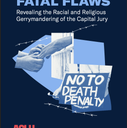
Acclaimed author John Grisham recently published an op-ed in the Washington Post questioning why Teresa Lewis is facing the death penalty when both her co-defendants, two men who actually committed the killings, were given life-without-parole sentences. According to Grisham, the judge who sentenced Lewis to death mistakenly believed that she was the “mastermind” behind the killings. However, it has now been revealed that her IQ of 72 makes her borderline intellectually disabled, that she suffered from a dependent personality disorder and other addictions, and that she lacked the basic skills necessary to organize a conspiracy to commit murder for hire. Grisham wrote, “In this case, as in so many capital cases, the imposition of a death sentence had little do with fairness. Like other death sentences, it depended more upon the assignment of judge and prosecutor, the location of the crime, the quality of the defense counsel, the speed with which a co-defendant struck a deal, the quality of each side’s experts and other such factors. In Virginia, the law is hardly consistent.” Read full op-ed below.
John Grisham: Teresa Lewis didn’t pull the trigger. Why is she on death row?
By John Grisham
Sunday, September 12, 2010
The Commonwealth of Virginia already has a serious relationship with its death penalty. In the past three decades, only Texas has executed more inmates. But on Sept. 23, the Old Dominion will enter new territory when it executes a female inmate for the first time in nearly a century.
Her name is Teresa Lewis, she is the only woman on death row at the Fluvanna Correctional Center for Women, and her appeals have all but expired. If she is executed, she will become another glaring example of the unfairness of our death penalty system.
Lewis is not innocent. She confessed to the police, pled guilty to the judge and for almost eight years has expressed profound remorse for her role in two murders.
As with most violent crimes, a recitation of the facts of this case would fill pages; still, a brief summary drawn from news reports, letters and affidavits is useful. In 2002, Lewis, then 33, lived with her second husband in a mobile home in a rural area near Danville. She was having an affair with a man named Matthew Shallenberger, who, though nothing more than a common thug, had ambitions. He was looking for seed money to establish a distribution ring for illicit drugs, but his real dream was to become an accomplished hitman, Mafia-style. He reasoned that if he could build his résumé, his reputation would spread all the way to New York, and he could somehow join the big leagues of contract killing.
Shallenberger had a partner named Rodney Fuller, and it is not clear if he was also afflicted with these grand ideas. What is clear is that the three — Shallenberger, Fuller and Lewis — participated in a scheme to kill Lewis’s husband for his money. At some point, the plans broadened to include the murder of her 25-year-old stepson, a National Guard member with a life insurance policy.
On the night of Oct. 30, 2002, Lewis left a door unlocked, got into bed with her husband and waited. Shallenberger and Fuller entered through the unlocked door, as planned. Shallenberger blasted the husband with a shotgun while, at the other end of the trailer, Fuller shot the stepson. Needless to say, the crime scenes were gruesome.
Lewis initially claimed that the killings were the work of an intruder, but the authorities suspected otherwise. After being confronted, she broke down, confessed and fingered Shallenberger and Fuller. All three were arrested and charged with capital murder.
Fuller’s lawyers were quick off the mark. They realized the futility of a defense and advised their client to cut a deal — to plead guilty and promise to testify against his two co-conspirators in exchange for life without parole.
Lewis’s lawyers likewise wanted no part of a jury trial. The evidence of their client’s guilt was overwhelming, and they felt strongly that, after hearing all the facts and seeing the color photos from the crime scene, any jury would be in a hanging mood. They advised Lewis to plead guilty and to take her chances with the trial judge who would determine her sentence. They believed this judge would give her life in prison because he had just sentenced Fuller to the same. Furthermore, Lewis had no criminal record and no history of violence. She had cooperated with the authorities. And no woman had received the death penalty in Virginia since 1912.
But Lewis was sentenced to die.
Up last was Shallenberger, who in the middle of his trial changed his plea to guilty. The trial judge (the same who had sentenced Fuller and Lewis) sentenced him to life in prison. Prosecutors had already promised life to Fuller, and it wouldn’t be fair, the judge reasoned, to give one of the triggermen death when the other got life.
The judge’s rationale in giving Lewis a death sentence was that she was more culpable than the men, who shot their victims as they slept. The killings were her idea, the judge reasoned; she was the mastermind; she recruited Shallenberger and Fuller to do the dirty work; she wanted the money; and so on.
Although much of this went unchallenged at Lewis’s sentencing hearing, it has since been challenged on appeal. Lawyers for Lewis have presented evidence that:
(1) She has an IQ of just above 70 — borderline retarded — and as such lacks the basic skills necessary to organize and lead a conspiracy to commit murder for hire;
(2) She has dependent personality disorder and therefore complied with the demands of those upon whom she relied, especially men;
(3) Because of a long list of physical ailments she had developed an addiction to pain medications, and this adversely affected her judgment; and
(4) She had not a single episode of violent behavior in the past.
Her lawyers have also argued that Shallenberger, who committed suicide behind bars in 2006, masterminded the murders. They have pointed to evidence that he had an IQ of 113 and was known to be intelligent and manipulative.
They have cited the sworn affidavit of a private investigator who interviewed Shallenberger in prison in 2004. This investigator said Shallenberger described Lewis as not very bright and as someone who could be easily duped into a scheme to kill her husband and stepson for money. According to the investigator, Shallenberger said: “From the moment I met her I knew she was someone who could be easily manipulated. From the moment I met her I had a plan for how I could use her to get some money.”
Lewis’s lawyers have also cited a letter Shallenberger sent to a girlfriend shortly after he was sentenced, in which he wrote, “I figured why go to New York for $20,000 a hit when I could do just one and make $350,000 off of it.” In the same letter he said of Lewis: “She was exactly what I was looking for.”
In addition, they have cited a 2004 affidavit by Shallenberger’s fellow assassin, Fuller, who said this: “As between Mrs. Lewis and Shallenberger, Shallenberger was definitely the one in charge of things, not Mrs. Lewis.”
Under Virginia law, Lewis, Fuller and Shallenberger are all guilty of murder.
Why, then, did the triggermen get life without parole while Lewis received a sentence of death? Ostensibly, it is because she was the ringleader and thus more culpable. But what could make a killer more culpable than repeatedly shooting a sleeping victim?
Lewis has appealed her case to the U.S. Supreme Court, but her chances do not look good. Her lawyers have also filed a petition for executive clemency with Gov. Bob McDonnell’s office; they are, as of this writing, awaiting a decision.
In this case, as in so many capital cases, the imposition of a death sentence had little do with fairness. Like other death sentences, it depended more upon the assignment of judge and prosecutor, the location of the crime, the quality of the defense counsel, the speed with which a co-defendant struck a deal, the quality of each side’s experts and other such factors.
In Virginia, the law is hardly consistent. There have been other cases with similar facts — a wife and her lover scheme to kill her husband for his money or for life insurance proceeds. But there is no precedent for the wife being sentenced to death.
Such inconsistencies mock the idea that ours is a system grounded in equality before the law.
(J. Grisham, “John Grisham: Teresa Lewis didn’t pull the trigger. Why is she on death row?,” Washington Post, September 12, 2010 (op-ed); Photo from JGrisham.com). See also Editorials and Clemency. Read DPIC’s Press Release on this case.



